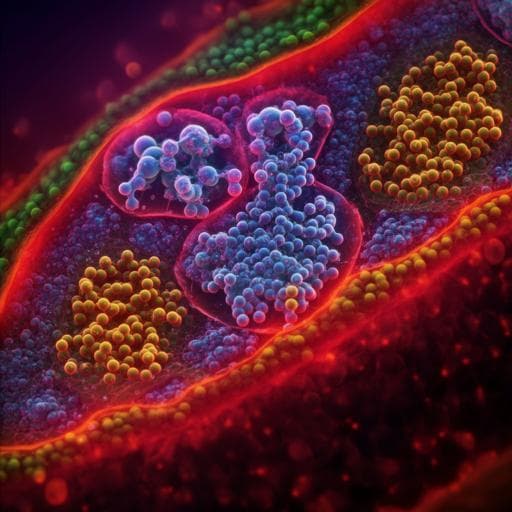
Biology
Increasing the resilience of plant immunity to a warming climate
J. H. Kim, C. D. Castroverde, et al.
This groundbreaking research conducted by Jong Hum Kim, Christian Denv. Castroverde, and their team unveils how climate change's extreme temperatures hinder salicylic acid production in plants, ultimately weakening their immune defenses. The study highlights the potential of optimizing *CBP60g* expression to enhance plant resilience against climate change.
~3 min • Beginner • English
Introduction
Salicylic acid (SA) production underpins effective plant immunity but is highly sensitive to short heat waves above the optimal growth range. Prior work showed SA production can be influenced by temperature within normal ranges and that other stress hormones (jasmonate, abscisic acid) tend to increase at higher temperatures. However, the mechanisms causing selective suppression of the SA pathway during supra-optimal heat events remained unclear. Understanding this mechanism is crucial for predicting how warming climates and more frequent extreme heat waves will affect plant immune effectiveness and for developing climate-resilient crops to safeguard agricultural productivity, ecosystems, and to mitigate risks of emerging plant disease pandemics.
Literature Review
Previous studies established that: (1) SA production is induced by immune activation and can be modulated by temperature-sensitive processes, including proton transmembrane relays within optimal growth ranges; (2) thermo-responsive growth and development are regulated by sensors such as phytochrome B (phyB) and EARLY FLOWERING 3 (ELF3); (3) elevated temperatures suppress effective-triggered immunity (ETI) and reduce SA accumulation after pathogen challenge; and (4) SA pathway suppression at elevated temperature appears conserved across species, with downregulation of SA-responsive genes observed in Arabidopsis and crop plants (e.g., tobacco and rice) after pathogen inoculation or benzothiadiazole (BTH) treatment. These findings framed the open question of which molecular nodes in the SA pathway constitute the temperature-vulnerable steps during heat waves.
Methodology
- Plant material and growth: Arabidopsis thaliana Col-0 (4–5 weeks old) grown at 23 °C or shifted to 28 °C to simulate short-term elevated temperature.
- Pathogen assays: Syringe infiltration with Pseudomonas syringae pv. tomato (Pst) DC3000 (virulent) and avirulent strains (avrPphB, avrRps4). Mock treatments with MgCl2. Bacterial growth quantified at designated dpi.
- Chemical treatments: BTH (synthetic SA analogue) applied to induce SA-responsive pathways; mock (DMSO) controls.
- Gene expression analyses: RNA-seq and RT–qPCR to measure transcript levels of SA biosynthesis (ICS1), SA-responsive genes, and immune regulators (CBP60g, SARD1, NPR1, etc.). GUS reporter assays for CBP60g promoter activity.
- SA quantification: Measurement of SA levels at 24 h post inoculation/treatment under 23 °C vs 28 °C.
- Protein and chromatin assays: ChIP–qPCR using tagged lines (NPR1:NPY1-YFP, 35S:eGFP–GBPL3, MED16:Flag, MED6) to assess promoter occupancy at CBP60g, SARD1, NPR1 loci; TA3 transposon used as negative control locus.
- Imaging: Confocal microscopy to visualize GBPL3 defence-activated condensates (GDACs) and assess their abundance and nuclear distribution at 23 °C vs 28 °C after mock/BTH treatments.
- Genetic lines evaluated: Overexpression or mutant lines including 35S:CBP60g, 35S:ICS1, NPR1 phosphomimetic (npr1-2S/D), npr3 npr4 double mutant, TGA1 overexpression, phyB activation lines, ELF3 overexpression; oUFR5-driven CBP60g to titrate expression and reduce growth trade-offs.
- Statistics: Two-way ANOVA with Tukey’s HSD for multiple comparisons; biological replicate numbers noted per experiment. Experiments repeated independently as indicated.
Key Findings
- Elevated temperature (28 °C) suppresses SA accumulation and SA biosynthetic gene (ICS1) expression in Arabidopsis after Pst DC3000 challenge, while early PTI signaling (MAPK activation) remains intact.
- SA pathway suppression at 28 °C extends to ETI-triggering strains and is observed across species (e.g., tobacco, rice) following pathogen or BTH elicitation, indicating a common plant feature.
- The suppression of SA at elevated temperature is independent of known thermosensors phyB and ELF3; lines with constitutively activated phyB/ELF3 remained temperature sensitive and more susceptible to Pst DC3000.
- Manipulating canonical SA biosynthesis or receptor nodes did not restore SA at 28 °C: 35S:ICS1 elevated basal SA at 23 °C but failed to restore pathogen-induced SA at 28 °C; NPR1 phosphomimetic activation and removal of antagonistic receptors (npr3 npr4) also failed to rescue.
- Elevated temperature reduces formation of GBPL3 defence-activated condensates (GDACs) and diminishes recruitment of GBPL3 to promoters of CBP60g and SARD1, master immune transcription factors.
- ChIP–qPCR showed temperature-dependent loss of Pol II, MED16 (Mediator tail), and MED6 (Mediator head) occupancy at the CBP60g promoter at 28 °C, while NPR1–TGA1–CDK8 module recruitment was largely unaffected; not all Mediator components were temperature sensitive (CDK8 unchanged).
- Evidence supports at least two GDAC subpopulations: a 28 °C-sensitive subset associated with CBP60g/SARD1 recruitment and a 28 °C-insensitive subset (e.g., NPR1 promoter association), with the number of GDAC-containing nuclei unchanged but fewer condensates per nucleus at 28 °C.
- CBP60g and SARD1 transcription are primary thermo-sensitive, rate-limiting nodes downstream of GBPL3 for SA production at elevated temperature.
- Overexpressing CBP60g (35S:CBP60g) restored pathogen-induced SA accumulation and basal/ETI immunity at 28 °C, and broadly reinstated expression of CBP60g target genes (including SA biosynthesis genes ICS1, PBS3 and PR genes), indicating CBP60g acts as a master regulator safeguarding multiple defense metabolites.
- An optimized expression strategy (oUFR5::CBP60g) maintained temperature-resilient SA responses and disease resistance at 28 °C while minimizing growth and developmental trade-offs (normal growth and flowering compared to constitutive overexpression).
Discussion
The study identifies a mechanistic basis for the heat-induced suppression of SA-mediated plant immunity that is independent of classic thermosensory pathways (phyB, ELF3) and upstream SA biosynthesis or receptor activation. Instead, elevated temperature compromises the assembly and/or function of GBPL3-dependent biomolecular condensates and the recruitment of specific Mediator components to the CBP60g and SARD1 promoters, diminishing transcription of these master immune regulators. This pinpoints CBP60g/SARD1 transcriptional control as a temperature-vulnerable bottleneck in the SA pathway. By elevating CBP60g expression, the authors restored SA accumulation and immune competence under heat stress, and reactivated broader defense transcriptional programs, demonstrating a practical route to engineer heat-resilient immunity. The delineation of temperature-sensitive versus temperature-insensitive GDAC subpopulations further refines understanding of how condensate-based transcriptional regulation is modulated by environmental temperature. These findings advance the field by shifting focus from general thermosensors or SA biosynthesis enzymes to condensate-mediated transcriptional control of master regulators as key intervention points for climate resilience.
Conclusion
This work reveals that elevated temperature suppresses SA-mediated immunity by impairing GBPL3 condensate formation and selective Mediator recruitment to the CBP60g/SARD1 promoters, thereby reducing transcription of these master immune factors. Engineering CBP60g expression—particularly using optimized, pathogen-responsive translational control—restores SA production and immunity at 28 °C with minimal growth penalties, providing a blueprint for developing climate-resilient crops. Future research should: (1) dissect the biophysical properties and composition of temperature-sensitive versus insensitive GDAC subpopulations; (2) map genome-wide temperature effects on GBPL3/Mediator recruitment; (3) translate CBP60g/SARD1 optimization strategies to diverse crops and field conditions; and (4) refine expression systems to balance defense benefits with growth and yield across varying thermal regimes.
Limitations
- Most experiments were conducted in Arabidopsis under controlled 23 °C vs 28 °C regimes; field variability and more extreme or fluctuating heat conditions were not tested.
- While CBP60g overexpression restored immunity, constitutive overexpression can incur developmental trade-offs (e.g., delayed flowering), necessitating careful expression control; long-term agronomic impacts were not evaluated.
- The precise molecular determinants by which temperature reduces GBPL3 condensate number per nucleus and Mediator recruitment remain unresolved.
- Although some Mediator and receptor components were assayed, comprehensive proteome stability and interactome changes at elevated temperature were not fully characterized.
- Cross-species validation beyond initial indications (tobacco, rice gene expression) and efficacy against diverse pathogens in crops require further testing.
Related Publications
Explore these studies to deepen your understanding of the subject.







